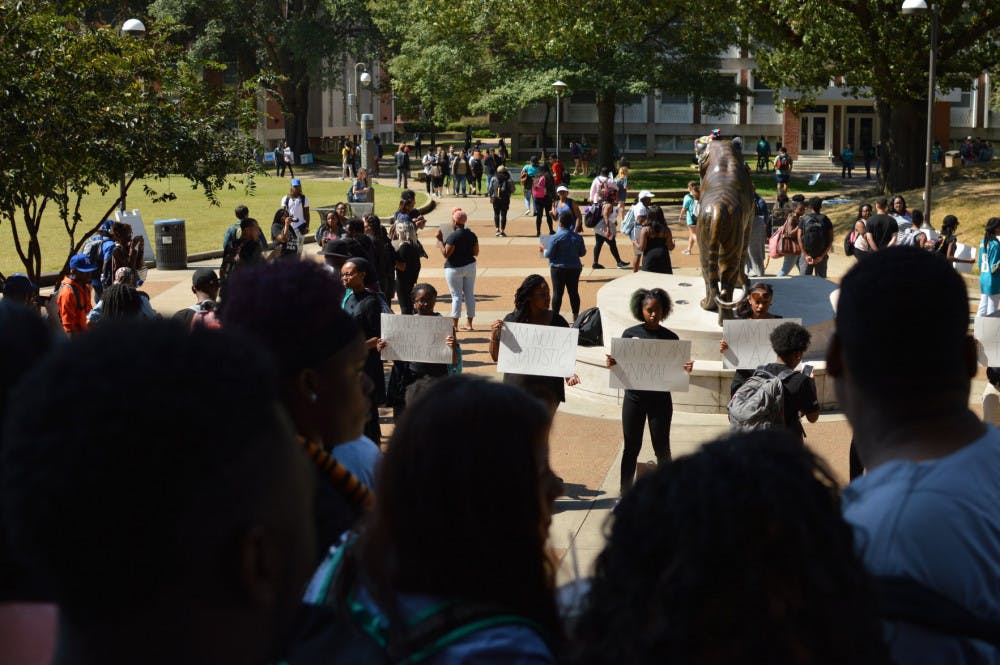A stern silence fell over the front of the University Center as the Black Student Association took a stand against inequality and peacefully protested.
During the campus afternoon rush, BSA members formed a circle around the Tom the Tiger statue, wearing all black and holding signs that defied African-American stereotypes. The posters that had statements like “I AM NOT A STATISTIC,” “I AM NOT A THUG” and “I AM NOT FATHERLESS” could be viewed from all angles around the statue.
Tierra Perry, president of the BSA, said the protest was in response to a racist note found on a student-athlete’s car last Thursday. University of Memphis officials classified the note as an act of “racism, bigotry and hate speech” through an email addressed to the entire campus community. Perry felt BSA needed to respond to the issue as well.
“I chose for it to be a silent protest because I was here for the ‘What Would Jesus Do’ protest, and that protest got out of control,” Perry said. “I thought the campus would be more receptive if we stood out there silently with our posters. I just feel with a note like that, it’s unacceptable, and I wanted administration to acknowledge what’s going on. Any student shouldn’t feel like they’re not welcome.”
“I think these students don’t want something like this on their campus, and they want their campus community to know about it.”
-Justin Lawhead, dean of students and associate dean for student leadership and involvement
After a discussion with Perry, U of M President M. David Rudd sent out an email addressing the issue of racism, which stated there will be a University Town Hall meeting Oct. 13.
Justin Lawhead, dean of students and associate dean for student leadership and involvement at the U of M, said he is proud of how students responded to the incident.
“I think these students don’t want something like this on their campus, and they want their campus community to know about it,” Lawhead said. “It takes courage. It takes planning. I think they want this university to be a reflection of the values that we as an institution aspire for.”
Lawhead said he hopes students understand the importance of diversity and the role it plays on campus.
“I think it will spark a dialogue, and it will help the entire student body understand the appreciation of differences and the inclusion of what higher education is all about,” Lawhead said.
Jared Moses, president of the Student Government Association, said the protest meant a lot to him, not only as the president of the student body, but as a black man.
“As SGA president, it shows that our students truly do believe in activism, and when they want to see change, they’re not afraid to take a stand on what’s going on,” Moses said. “No matter the timing of the event, it’s an overall picture that demonstrates they’re not those stereotypes.”
Moses said he thinks the protest is a good start for more movements of activism and for the university to set a standard for the city of how we can grow past racial division.
“It should create a good conversation amongst students,” Moses said. “As a black man, I totally agree with these protests to help start the conversation.”
Other students also felt the protest was a good way to stand up against racism.
“Being a college student and being a kid of this generation, it’s great to see we can come together and stand for what’s right,” Xynarrhea Rufus, sophomore member of Delta Gamma, said. “I think the message will definitely get across to some students. Just to see students standing in the hot sun in all black protesting says something. Everyone came from inside of the UC just to see the protest.”
Jack Callahan, junior at the U of M, appreciated the protest was silent and said it stood out because of that.
“It keeps it from raising chaos,” Callahan said. “If it’s silent, it makes more of a stand. I think students will notice it whether it’s a lasting impression or not. I think some students will forget about it because everything dies down, but for the next couple of weeks I think it will definitely make a stand.”
Junior Keenon Robinson said the protest meant a lot, especially for it to be on a “PWI” campus. According to USA Today, “PWIs” are predominantly white institutions and are typically schools of higher learning where whites account for at least 50 percent of enrollment.
“Being in the black community, you rarely see people coming together for a good cause,” Robinson said. “The message may not get across to everyone, but it will definitely inspire someone. I feel the racism on campus is undercover. We don’t have a lot of open racism, but you will hear about slick stuff that happens.”
Students at the U of M will get a chance to voice their opinion on the matter at the Town Hall meeting Oct. 13 at 3 p.m. in the UC theatre.




